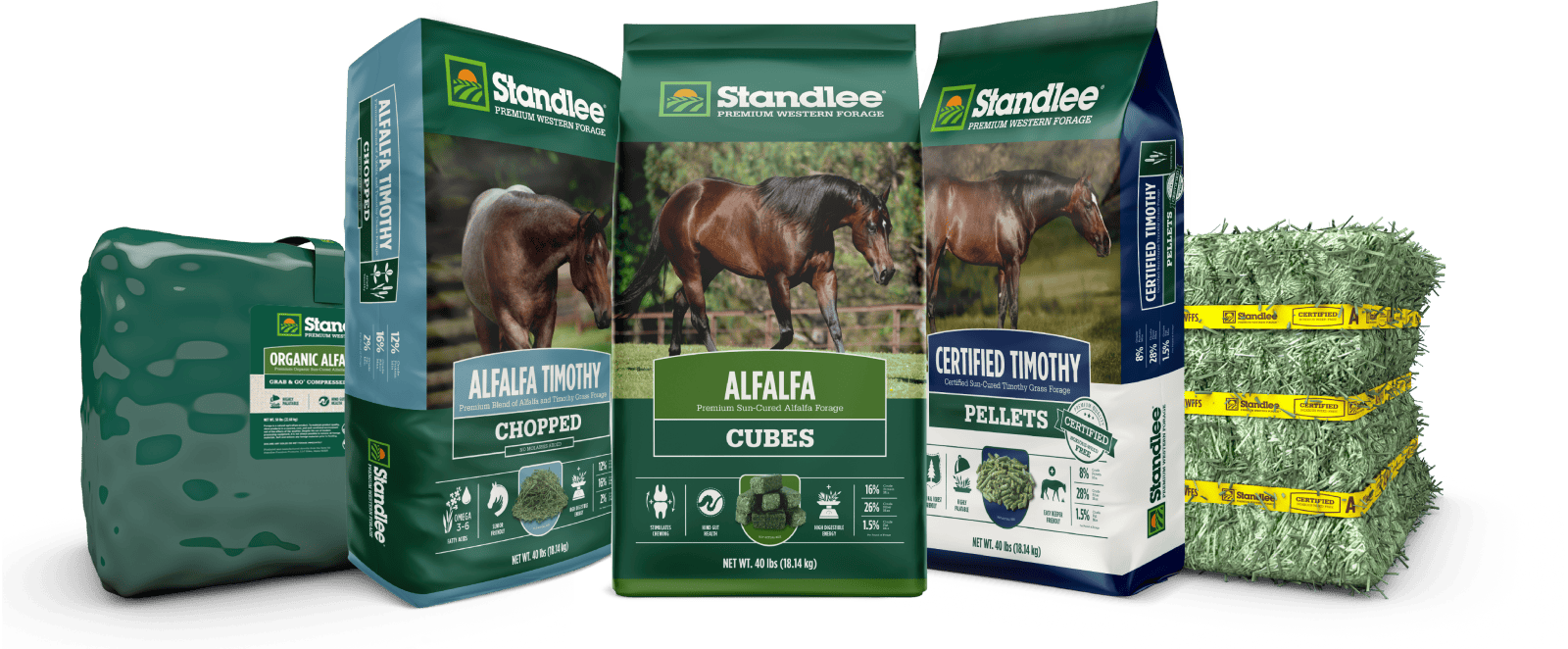HAY IN SHORT SUPPLY? HORSE FORAGE ALTERNATIVES FROM STANDLEE PREMIUM PRODUCTS
Dr. Tania Cubitt and Dr. Stephen Duren, Performance Horse Nutrition and Standlee Premium Products Nutritional Consultants
This year, much of the United States is experiencing weather patterns that are not favorable to growing quality horse forage. Extreme drought or heavy rain fall has plagued many prime forage growing areas. The net result is less high quality forage available for horses. Therefore, horse owners should familiarize themselves with alternative fiber sources that can be used to supplement their horse’s diet if forage becomes scarce.
No matter the breed or intended use, all horses require fiber in their diets. Good quality forage or pasture should make up at least half of most horse’s diets. Horses will readily eat many types of grass and legume forage, especially if it is of high quality. In the absence of high quality local forage sources, horse owners must find alternative forage options. Some alternatives from Standlee Premium Western Forage® include: forage cubes, forage pellets, chopped forage and fiber byproducts.
Forage Cubes

Standlee Premium Western Forage® makes several types of forage cubes for horses, including alfalfa, alfalfa/oat, and alfalfa/timothy. Forage cubes are an excellent fiber source for horses, and they are generally accessible at most feed stores. Forage cubes are made from coarsely chopped forage that is pressed with heat, steam and a little bit of bentonite (natural clay agent) into a cube. Storage, handling ease and decreased wastage are advantages offered by cubes. Forage cubes can be fed just like hay, at a 1:1 ratio of the like hay type the horse currently consumes. For example, you would replace five pounds of alfalfa hay with five pounds of alfalfa cubes and adjust the amount if needed to maintain the animal’s proper weight. Forage cubes can be hard so it is recommended that forage cubes be soaked in water for 10 minutes before feeding to soften them. A secondary advantage to wet-ting forage cubes is it can slow down the rate of intake by the horse.
Forage Pellets

Standlee Premium Products makes several types of forage pellets for horses, including alfalfa, organic alfalfa, alfalfa/timothy, orchard grass and timothy grass. To make pellets, Standlee grinds dried forage to a small particle size, and with the addition of heat and steam, forms the forage into pellets. Like forage cubes, forage pellets can be fed just like hay, at a 1:1 ratio to replace hay. Forage pellets are the fiber choice for horses that have lost teeth or have poor dentition since forage pellets can easily be soaked in water to form a mash or slurry.
Chopped Forage

Standlee Premium Products makes two types of chopped forage for horses, chopped alfalfa and chopped alfalfa/timothy. Both chopped products are blended with a light coating of canola oil to decrease dust and increase caloric content. Canola oil is also a rich source of Omega-3, 6 and 9 fatty acids, which are essential for skin and hair coat care, as well as general health. Chopped forage can be fed along with a grain meal to slow the rate of intake as well as increase the fiber content of the diet. Chopped forage can be fed along with a grain meal to slow the rate of intake as well as increase the fiber content of the diet. Chopped forage can also be used to increase the size of the meal to eliminate potential stall vices for horses that are confined and only receiving small grain meals. Finally, chopped products offer an excellent vehicle to get oral medications into horses.
Byproducts

Standlee Premium Products offers beet pulp shreds and beet pulp pellets. Beet pulp is a byproduct of the sugar industry. In this process, sugar is removed from the beet and the remaining pulp is dried forming beet pulp shreds, or dried and pelleted forming beet pulp pellets. Beet pulp is a highly digestible, low sugar fiber source for horses. Beet pulp is safe to feed like hay, but contains the energy equivalent of an equal weight (dry weight) of oats. Since beet pulp is dehydrated, it is recommended to soak it in water for a minimum of 15 minutes prior to feeding to the horse. Due to the labor of soaking and preparing beet pulp, most horses are only fed a maximum of 0.5% of body weight per day as dry beet pulp.
Use of Forage Alternatives

Selection of any Standlee Premium Product will provide high quality forage for your horse. To avoid digestive upset, the new forage products should be introduced gradually into the diet during a 7-10 day period. It is also recommended that you begin feeding these forage alternatives prior to running out of your existing hay. In other words, replacing an increasing portion of their regular hay on a daily basis is a less drastic dietary change than to suddenly make a total switch of their forage source. If you are replacing lower quality hay with a higher quality forage product, you may need to feed less based on the body condition of the horse.
If you have questions about the use of Standlee Premium Products, please feel free to contact us at 800-398-0819 or visit our website at www.standleeforage.com.

